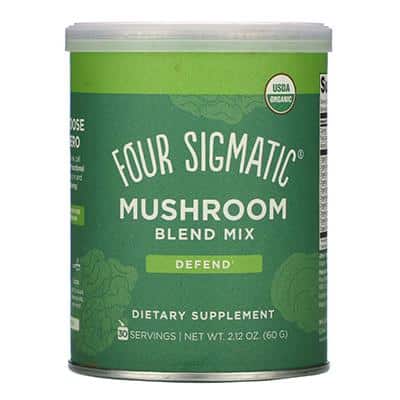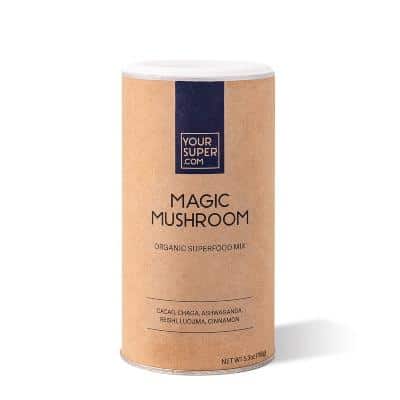

ALEKSEI BEZRUKOV / iStock / Getty Images
When it comes to the ingredients to seek out in a daily supplement or vitamin subscription, mushroom powder may not top your list. That could soon change, as fungi are gaining attention for their impressive health benefits.
Whether you’re looking to switch out your morning coffee for adaptogenic mushrooms or merely want to give yourself an extra edge at the gym, here’s what you need to know about mushroom extracts to choose the best mushroom supplements for your situation.
What are Mushroom Supplements?
Mushroom supplements are wellness products that contain dried mushroom extract, either in capsules or as a loose powder. Most people blend the powder in hot water to drink straight, although you can also add it to soup, smoothies, oatmeal, and other foods, just like a plant based protein powder. Some even use mushroom powders as a healthy energy drink to replace their morning coffee.
These supplements aim to provide the maximum benefits of adaptogenic mushrooms in a highly concentrated form. Many of the varieties may offer health benefits ranging from increased energy and better athletic performance to cognitive enhancement and more. Certain mushroom supplements can work like supplements to boost your immune system and help you fight off infections.
Where should you start? Here are the brands of mushroom powder supplements worth considering.
Our Picks for the Best Mushroom Supplements
Each product featured here has been independently selected by the writer. Check out our full review methodology here. If you make a purchase using the links included, we may earn a commission.
- Best Coffee Substitute: MUD/WTR
- Best Overall: Medterra Wellness Capsules
- Best Mushroom Powder: Four Sigmatic Mushroom Blend
- Best Value: NOW Cordyceps 750 mg Veg Capsules
- Best for Stress: Your Super Magic Mushroom Mix
- Best for Cognitive Enhancement: Vital Plan Brain Boost
- Best for Exercise Enthusiasts: ONNIT Shroom TECH Sport
- Most Versatile: Goldmine Supershroom Immunity Support
How We Chose the Best Mushroom Supplements
Here are the primary factors we considered when comparing the best mushroom supplements on the market today.
- Types of Mushrooms – Does the supplement contain one variety of mushroom or many? Are the types of mushrooms included known for specific health benefits?
- Mushroom Concentration – How many milligrams of mushrooms are in each serving?
- Other Ingredients – Does the mushroom powder contain filler ingredients or flavoring agents?
- Payment System – Can you make a one-time purchase, or is a subscription required?
- Instructions for Use – Will the mushroom extract be taken through a supplement or dissolved in liquid?
The 8 Best Mushroom Supplements of 2021
Best Coffee Substitute: MUD/WTR

mudwtr.com
- Mushrooms – USDA certified organic chaga, cordyceps, reishi, lion’s mane
- Strength – 562 mg of each mushroom per serving (2,248 mg total)
- Other Ingredients – USDA certified organic marsala chai, turmeric, sea salt, cinnamon, cacao
Why buy: MUD/WTR brands itself as the best upgrade to your morning ritual for a day of focus and sustained energy. Unlike the other mushroom powders listed here, MUD/WTR includes caffeine through black tea. Don’t expect it to leave you jittery, as each serving contains just 1/7 of the caffeine within a cup of coffee.
Each of MUD/WTR’s four mushroom varieties is grown organically throughout Carlsbad, CA, and collectively deliver a higher concentration of mushroom extract than the other supplements listed here. Taste-wise, think of a spicy, chocolatey chai tea.
Best Overall: Medterra Wellness Capsules

medterracbd.com
- Mushrooms: Cordyceps
- Strength: 200 mg of mushroom per capsule
- Other Ingredients: Broad-spectrum hemp extract, rhodiola, schisandra, guarana
Why buy: Medterra Wellness Capsules combine medicinal mushrooms with broad-spectrum hemp extract and other herbal ingredients to help boost your wellbeing in distinct ways. We like the “Energy” option because it contains cordyceps extract plus 25 mg of broad-spectrum hemp extract per capsule that can help you feel more focused and energetic without relying on caffeine. The other Wellness Capsule options from Medterra include “Eye Health,” “Sleep Well,” and “Stress Support.” Each option is THC-free and tested by third-party labs.
Best Mushroom Powder: Four Sigmatic Mushroom Blend

foursigmatic.com
- Mushrooms: USDA certified organic chaga, reishi, cordyceps, lion’s mane, shiitake, maitake, enoki, agaricus blazei, meshima, and tremella mushrooms
- Strength: 1,500 mg of mushroom per serving
- Other Ingredients: USDA certified organic rose hips
Why buy: Four Sigmatic is one of the most prominent brands in the powdered mushroom market, and this blend really packs in the fungi. It contains ten varieties of functional mushrooms that work together to boost immune system functioning and give you the benefits of some of the most nutrient-dense foods on the planet. It’s also 100% free of caffeine, so you can enjoy it at any time – just pour the powder into water or your favorite mixer.
Best Value: NOW Cordyceps 750 mg Veg Capsules

nowfoods.com
- Mushrooms – Cordyceps
- Strength – 1,500mg per serving (two capsules)
- Other Ingredients – Cellulose, cellulose powder, stearic acid
Why buy: These cordyceps supplements are formulated to fight free radical damage and support better immune system functioning. They have a stripped-down ingredients list that focuses on the mushroom powder for better blood flow and a boost of energy. While you get an impressive dose (1,500mg) of mushrooms per serving, the NOW brand doesn’t share much information about its ingredient sourcing or clinical testing.
Best for Stress: Your Super Magic Mushroom Mix

yoursuper.com
- Mushrooms: USDA certified organic chaga and reishi mushrooms
- Strength: 5 grams of mix per serving
- Other Ingredients: USDA certified organic cacao, ashwagandha, lucuma, and cinnamon
Why buy: This Magic Mushroom Mix from Your Super can provide a powerful mix of USDA organic and antioxidant-rich ingredients designed to support your immune system and help you manage stress. The mix of organic chaga and reishi mushrooms, paired with organic cacao, aswagandha, lucuma, and cinnamon, offers a chocolate and cinnamon flavor that’s perfect for making a mushroom hot chocolate or mixing with oatmeal. We like that its vegan, gluten-free, soy and dairy free, and is tested by third-party labs for quality.
Best for Cognitive Enhancement: Vital Plan Brain Boost

vitalplan.com
- Mushrooms – Lion’s mane extract
- Strength – 500 mg per serving (four capsules)
- Other Ingredients – cat’s claw bark extract, bacopa leaf extract, ashwagandha leaf and root extract, ginkgo leaf extract, rice complex, plant-based magnesium stearate, plant cellulose, water
Why buy: This natural nootropic blend is designed to promote brain and cognitive health, especially regarding the effects of aging. The supplement is advertised as a long-term solution to the brain fog most of us attempt to treat with caffeine each day. These benefits include supporting cerebral circulation, promoting immune health, maintaining microbiome balance, managing stress, and providing long-term daily support.
Best for Exercise Enthusiasts: ONNIT Shroom TECH Sport

onnit.com
- Mushrooms – Cordyceps
- Strength – 1,200 mg per serving (four capsules)
- Other Ingredients – Green tea extract, rhodiola, methyl B-12, vegetarian capsule, rice hull concentrate, dicalcium phosphate, dextrin, mineralized red algae, maltodextrin
Why Buy: Onnit Shroom TECH Sport mushroom powder supplements claim to help you reach your full athletic potential. Each capsule contains cordyceps mushrooms, which are scientifically proven to increase how much energy the body delivers to your muscles for more efficient use of oxygen.
According to brand-sponsored clinical research, the capsules will purportedly help you perform at high intensity for longer periods—meaning they can benefit everyone from seasoned athletes to those who want to better sustain their sprints in spin class. ONNIT supplements aren’t designed for everyday use like the others on this list. Instead, you’ll take up to four capsules before an intense workout, taking care not to consume more than six within 24 hours.
Most Versatile: Goldmine Supershroom Immunity Support

drinkgoldmine.com
- Mushrooms: USDA certified organic reishi, turkey tail, and maitake
- Strength: 1.49 g per serving
- Other Ingredients: USDA certified organic astragalus, ginger, and lucuma
Why buy: Goldmine Immunity Support powder comes from a woman-founded modern wellness brand. It blends four mushrooms known for boosting the immune system, along with lucuma and ginger, to make the drink easy on digestion.
The powder is formulated around fighting adrenal fatigue to keep you refreshed and functioning at a higher level all day. Its mushrooms are hot water extracted for three hours to increase the solubility of their beta-glucans, a fiber that aids digestion. As the mushrooms are never separated from the extraction fluid, all their beneficial compounds remain within the final product.
The Research on Mushroom Supplements
While mushrooms have long enjoyed culinary prominence, they are gaining attention globally for their medicinal benefits. Mushrooms are low in calories, relatively high in protein and fiber, and considered rich sources of essential B vitamins, potassium, copper, and selenium.
Each variety of mushroom typically included in supplements offers distinct health benefits. For example, lion’s mane mushrooms are purported to fight off the effects of inflammation to support immune system function, especially for the intestines. The fungus also shows promise for treating anxiety and depression. One study found that women who ate cookies containing lion’s mane extract reported less irritation and stress than the control group.
Cordyceps mushrooms are linked to better athletic performance. They increase the body’s production of adenosine triphosphate (ATP) for more efficient oxygen usage so you can go longer before getting exhausted. Early evidence shows their antioxidant content might mean they fight symptoms of aging by improving memory and sexual function, and they may even help manage type 2 diabetes by decreasing blood sugar levels.
Finally, reishi mushrooms show promise for their anti-cancer properties. The fungus has effectively killed off cancer cells within a lab setting, and preliminary research found that a year of treatment with reishi shrunk the size and number of tumors within the large intestine. These results, however, are very early and further study is needed to evaluate the effectiveness of these mushrooms for treatment of any disease.
How to Choose the Right Mushroom Supplement
When shopping for the best mushroom supplement, there are critical pieces of information you should seek out. Here’s our advice for how to compare brands to find the best product for you.
Mushroom Type
Some mushroom powders contain only one variety, while others include up to ten types per serving. Mushrooms aren’t interchangeable, so make sure you know which ones you’ll be ingesting so you can determine whether they offer the right benefits for your situation.
Lab Testing
Many mushroom supplement brands have undergone third-party lab testing for purity and safety. Look for signs on the packaging that the brand has invested in proving it contains what it claims.
Ingredient Origin
Mushrooms in supplements are sourced from around the world, and some regions are more reliable than others. It’s best to look for supplements that contain mushrooms grown in the United States, and preferably organically.
Concentrations
Look at the nutrition facts to determine how much powdered mushroom is actually contained within each serving and how many scoops or pills you need to take per dose. Some require you to take up to eight mushroom capsules per day—which may be more than you want to deal with.
Filler Ingredients
Some mushroom supplements contain artificial flavors, colors, binding ingredients, and other compounds you don’t want to ingest. Scan the ingredients list to ensure nothing has snuck into the formula.
How To Use Mushroom Supplements
Most mushroom supplements come in one of two forms. They are either powdered or encapsulated.
You can treat mushroom powder similar to instant coffee or collagen supplements. Simply add the powder as directed to hot water (or your beverage of choice) for a health boost. As most mushroom powders are caffeine-free, you can take them at any time of day. However, some people may have stomach sensitivities that make them better on an empty stomach.
Encapsulated mushroom powder should be taken just like other dietary supplements. Note that most brands suggest taking multiple capsules multiple times per day for full benefits.
Safety and Side Effects
As with most natural supplements, there are certain risks associated with mushroom powder.
Most are considered safe at the recommended doses. However, some, such as reishi, may lead to side effects like dizziness, dry mouth, nausea, and other digestive issues. In addition, formulations that contain ashwagandha may trigger iron retention, so those with hyperthyroidism or Grave’s disease should avoid them. Finally, cordyceps mushrooms are linked to mild side effects like diarrhea and constipation after regular use for some people.
As always, those who are pregnant or nursing or who have preexisting health concerns should talk with their doctor before taking any mushroom extract supplement.
Takeaway
Mushroom powders offer a potent dose of beneficial compounds that may help your body function at its best. However, these products aren’t the magic elixirs their manufacturers might claim. Keep your expectations realistic and take them as directed, and you may soon notice improvements in your energy levels and overall mood each day.
Lydia Noyes is a freelance writer specializing in health and wellness, food and farming, and environmental topics. When not working against a writing deadline, you can find Lydia outdoors where she attempts to bring order to her 33-acre hobby farm filled with fruit trees, heritage breed pigs, too many chickens to count, and an organic garden that somehow gets bigger every year.
- 5 Best Collagen Supplements for Joint and Muscle Health 2021 ...
- Top Healthy Energy Drinks and Coffees - EcoWatch
- 10 Best Vitamin Subscriptions: 2021 Guide and Brand Reviews ...
- Look Out, Bone Broth: Mushroom Broth Might Be Even More Magical ...
- 2021 Best Supplements to Boost Your Immune System Reviewed ...
- 5 Reasons You Should Eat Shiitake Mushrooms - EcoWatch
- 9 Best Energy Supplements to Try in 2021
- 6 Best Antioxidant Supplements to Try in 2021
- 6 Health Benefits of Reishi Mushrooms

 233k
233k  41k
41k  Subscribe
Subscribe 